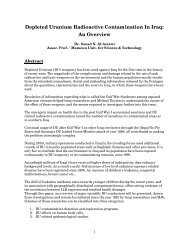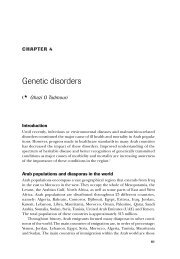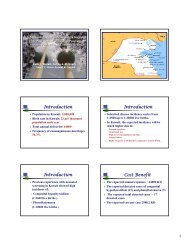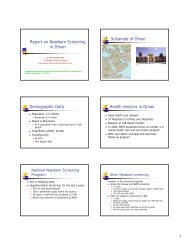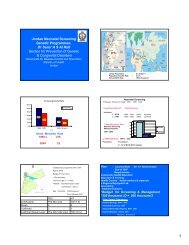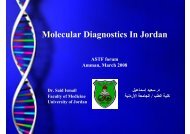Cancer Incidence in Postwar Lebanon: Findings ... - Jeans4genes.org
Cancer Incidence in Postwar Lebanon: Findings ... - Jeans4genes.org
Cancer Incidence in Postwar Lebanon: Findings ... - Jeans4genes.org
You also want an ePaper? Increase the reach of your titles
YUMPU automatically turns print PDFs into web optimized ePapers that Google loves.
<strong>Cancer</strong> <strong>Incidence</strong> <strong>in</strong> <strong>Postwar</strong> <strong>Lebanon</strong>: F<strong>in</strong>d<strong>in</strong>gs from the First National<br />
Population-based Registry, 1998<br />
ALI SHAMSEDDINE, MD, ABLA-MEHIO SIBAI, PHD, NAGEEB GEHCHAN, MD, BOUSHRA<br />
RAHAL, MPH, NAGI EL-SAGHIR, MD, MARWAN GHOSN, MD, GEORGES AFTIMOS, MD,<br />
NABIL CHAMSUDDINE, MD, AND MUHIEDDINE SEOUD, MD, FACOG, FOR THE LEBANESE<br />
CANCER EPIDEMIOLOGY GROUP*<br />
PURPOSE: <strong>Cancer</strong> <strong>in</strong>cidence rates <strong>in</strong> <strong>Lebanon</strong> have been lack<strong>in</strong>g for over three decades. National data<br />
based on a total of 4388 cases diagnosed dur<strong>in</strong>g the year 1998 were reviewed and analyzed.<br />
METHODS: Crude and age-standardized rates (ASRs) per 100,000 population were calculated and<br />
results were contrasted with estimates from developed and selected develop<strong>in</strong>g countries <strong>in</strong> the region.<br />
RESULTS: Among males, bladder (18.5%), prostate (14.2%), and lung cancer (14.1%) were the most<br />
frequently reported malignancies. Among females, breast cancer alone accounted for over a third of all<br />
cancers, followed by colon cancer (5.8%), and cancer of the corpus uteri (4.8%). Sex-differentials <strong>in</strong><br />
<strong>in</strong>cidence rates were highest for tobacco-related cancers (lung, larynx, and bladder). Compared with<br />
current estimates worldwide, ASRs for bladder cancer <strong>in</strong> <strong>Lebanon</strong> showed strik<strong>in</strong>gly high rates. Whereas<br />
ASRs for breast and prostate cancer rema<strong>in</strong>ed lower than those observed <strong>in</strong> developed countries, they<br />
were greater than those estimated from neighbor<strong>in</strong>g countries with a similar epidemiological transition<br />
as <strong>Lebanon</strong>.<br />
CONCLUSIONS: F<strong>in</strong>d<strong>in</strong>gs of the comparative assessments most likely reflect differentials <strong>in</strong> prevalence<br />
of risk factors and lifestyle variables (e.g., lung and breast cancers) and can be partly expla<strong>in</strong>ed by<br />
improvement <strong>in</strong> cancer detection rate <strong>in</strong> recent years (for prostate cancer). The implications of the<br />
results <strong>in</strong> light of primary prevention activities, screen<strong>in</strong>g practices, and research <strong>in</strong>itiatives <strong>in</strong> <strong>Lebanon</strong><br />
are discussed.<br />
Ann Epidemiol 2004;14:663–668. 2004 Elsevier Inc. All rights reserved.<br />
KEY WORDS: <strong>Cancer</strong>, <strong>Incidence</strong>, Registry, <strong>Lebanon</strong>, Middle-East.<br />
INTRODUCTION<br />
Population-based cancer registries are a valuable source of<br />
<strong>in</strong>formation and a public health surveillance tool for cont<strong>in</strong>-<br />
From the Division of Medical Oncology, Department of Internal Medic<strong>in</strong>e,<br />
American University of Beirut Medical Center (AUB-MC) Beirut,<br />
<strong>Lebanon</strong> (A.S., N.E.-S.); Department of Epidemiology and Population<br />
Health, Faculty of Health Sciences, American University of Beirut (A.-<br />
M.S.); Department of Surgical Oncology, Lebanese University Medical<br />
School and St. Ge<strong>org</strong>es Hospital, Beirut, <strong>Lebanon</strong> (N.G.); Department of<br />
Epidemiology and Population Health, Faculty of Health Sciences, American<br />
University of Beirut, Beirut, <strong>Lebanon</strong> (B.R.); Division of Medical<br />
Oncology, Hotel Dieu de France University Medical Center, Beirut, <strong>Lebanon</strong><br />
(M.G.); Department of Pathology, St. Ge<strong>org</strong>es Hospital Beirut, <strong>Lebanon</strong><br />
(G.A.); Department of Medical Oncology, St. Ge<strong>org</strong>es Hospital,<br />
Beirut, <strong>Lebanon</strong> (N.C.); and Division of Gynecological Oncology, Department<br />
of Obstetrics and Gynecology, AUB-MC, Beirut, <strong>Lebanon</strong> (M.S.).<br />
Address correspondence to: Abla-Mehio Sibai, Ph.D., Department of<br />
Epidemiology and Population Health, Faculty of Health Sciences, American<br />
University of Beirut, P.O. Box 11-0236, Riad El Solh, Beirut 11072020,<br />
<strong>Lebanon</strong>. Tel.: 961-1-350000; Fax: 961-1-744470. E-mail: ansibai@<br />
aub.edu.lb<br />
*A list of the Group Members appears at the end of the article.<br />
This study was funded by Terry Fox and Aventis Pharmaceutical Company<br />
(A/C 11411024304).<br />
Received January 17, 2003; accepted December 4, 2003.<br />
uous monitor<strong>in</strong>g of cancer patterns and trends and for fram<strong>in</strong>g<br />
health policy <strong>in</strong> cancer prevention and control (1–3).<br />
Initial attempts at establish<strong>in</strong>g a national cancer registry <strong>in</strong><br />
<strong>Lebanon</strong>, a small (population around 3.3 million) middle<strong>in</strong>come<br />
country located on the Eastern shore of the Mediterranean<br />
Sea, were made <strong>in</strong> the early 1970s. However these<br />
efforts failed due to a lack of f<strong>in</strong>ancial and technical<br />
resources caused by the civil war that ravaged the country<br />
from 1975 until 1991. More recent efforts at establish<strong>in</strong>g a<br />
cancer registry have also proved fruitless. Consequently,<br />
cancer <strong>in</strong>cidence data have been lack<strong>in</strong>g for over three<br />
decades. The only study published, which exam<strong>in</strong>ed <strong>in</strong>cidence<br />
rates, was undertaken <strong>in</strong> 1966 and was based on<br />
pathology reports from the eight <strong>in</strong>stitutions where histopathological<br />
diagnoses were made (4). Later on, several<br />
attempts were made at exam<strong>in</strong><strong>in</strong>g major sites of cancer <strong>in</strong><br />
<strong>Lebanon</strong> and their epidemiological characteristics. Studies<br />
have relied primarily on hospital-based tumor registries with<br />
<strong>in</strong>consistent results (5–8). Factors such as referral and selection<br />
biases due to availability or <strong>in</strong>troduction of specialized<br />
diagnostic and therapeutic services with<strong>in</strong> certa<strong>in</strong> healthcenters<br />
resulted <strong>in</strong> unreliable rank<strong>in</strong>g estimates and have<br />
h<strong>in</strong>dered extrapolation of f<strong>in</strong>d<strong>in</strong>gs to the total population.<br />
2004 Elsevier Inc. All rights reserved. 1047-2797/04/$–see front matter<br />
360 Park Avenue South, New York, NY 10010 doi:10.1016/j.annepidem.2003.12.002
664 Shamsedd<strong>in</strong>e et al.<br />
CANCER INCIDENCE IN LEBANON<br />
AEP Vol. 14, No. 9<br />
October 2004: 663–668<br />
Selected Abbreviations and Acronyms<br />
ASR age standardized rate<br />
AUB-MC American University of Beirut Medical Center<br />
ICD-O International Classification of Disease for Oncology<br />
LCEG Lebanese <strong>Cancer</strong> Epidemiology Group<br />
PHS Population and Hous<strong>in</strong>g Survey<br />
With a commitment to exam<strong>in</strong>e cancer <strong>in</strong>cidence rates<br />
at the national level, the Lebanese <strong>Cancer</strong> Epidemiology<br />
Group (LCEG), a network of all hospitals with oncology specialists<br />
and all pathology laboratories, was established. In<br />
this study, we present f<strong>in</strong>d<strong>in</strong>gs based on 4388 <strong>in</strong>cident<br />
cases that were reported and registered <strong>in</strong> the year 1998.<br />
A comparison is made with data from developed countries<br />
and other selected develop<strong>in</strong>g countries <strong>in</strong> the region. The<br />
analysis provides leads to researchers <strong>in</strong>volved <strong>in</strong> etiologic<br />
studies and to policy makers for evidence-based health<br />
plann<strong>in</strong>g.<br />
METHODS<br />
The LCEG operates <strong>in</strong> close collaboration with the American<br />
University of Beirut Medical Center (AUB-MC) Tumor<br />
Registry and the Lebanese <strong>Cancer</strong> Society. Registry personnel<br />
at AUB-MC collected pathology reports for the year<br />
1998 from all collaborat<strong>in</strong>g centers (the 12 hospitals with<br />
oncology specialist(s) and the 6 diagnostic centers and pathology<br />
laboratories) <strong>in</strong> various districts of the country. The<br />
<strong>in</strong>formation entered <strong>in</strong> the registry <strong>in</strong>cluded the patient’s<br />
name, sex, date and age at diagnosis, address, anatomical<br />
site, and histological type. Carc<strong>in</strong>oma <strong>in</strong> situ, except for<br />
breast cancer, was excluded because these were not logged<br />
as cancers <strong>in</strong> many laboratories’ register books. Furthermore,<br />
as most facilities exclude patients with basal and squamous<br />
cell carc<strong>in</strong>oma, only sk<strong>in</strong> melanomas were <strong>in</strong>cluded. The<br />
method of classification of lymphoma was done by disease not<br />
by site. All other cancers were coded accord<strong>in</strong>g to the International<br />
Classification of Disease for Oncology (ICD-O) (9).<br />
Patients who resided outside <strong>Lebanon</strong> were excluded. Proportion<br />
of cases with unknown primary site was around<br />
1%. Data were computerized us<strong>in</strong>g Access Software with<br />
modules for detect<strong>in</strong>g duplicate registrations of the same<br />
cancer case.<br />
For estimation of population data, the age- and sexdistribution<br />
for the year 1998 were projected from the Population<br />
and Hous<strong>in</strong>g Survey (PHS) conducted by the<br />
Lebanese Government <strong>in</strong> 1995 (10). The PHS was a<br />
large-scale survey of approximately one-tenth of all households<br />
<strong>in</strong> the country, thus, mak<strong>in</strong>g available the first reliable<br />
source of demographic data for a country emerg<strong>in</strong>g<br />
from 16 years of wars and conflict. Age-specific mortality<br />
rates were based on the West Model, and the Pap Child<br />
Survey was used to estimate fertility and sex-specific death<br />
rates (11). The annual growth rate (2.1%) was obta<strong>in</strong>ed<br />
from the study conducted by the Council of Development<br />
and Reconstruction <strong>in</strong> 1995 (12). The projected population<br />
estimates for 1998 <strong>in</strong>dicated a total of 1,623,230 males and<br />
1,649,620 females.<br />
Frequencies of various types of cancer were computed.<br />
Crude and age-specific <strong>in</strong>cident rates per 100,000 population<br />
and median age at diagnosis were calculated for males<br />
and females separately. For comparability with published<br />
literature, age standardized rates (ASRs) per 100,000 were<br />
estimated by the direct method us<strong>in</strong>g the world standard<br />
population (13), and these were compared with ASRs from<br />
selected neighbor<strong>in</strong>g and developed countries worldwide.<br />
RESULTS<br />
Dur<strong>in</strong>g the year 1998, a total of 4388 new cancer cases<br />
were diagnosed of which 52.3% were males. Among males,<br />
the most frequently reported cancer was bladder (18.5%),<br />
followed by prostate (14.2%), and lung cancer (14.1%)<br />
(Table 1). Among females, breast cancer alone constituted<br />
around one third of the total cancer caseload <strong>in</strong> the country.<br />
This was followed by colon cancer (5.8%), and cancer of<br />
the corpus uteri (4.8%) (Table 2). Crude <strong>in</strong>cidence rates<br />
for all cancers comb<strong>in</strong>ed were overall larger for males than<br />
females (141.4 and 126.8 per 100,000, respectively). When<br />
exam<strong>in</strong>ed by site, sex differentials were notably substantial<br />
for cancers of the larynx, lung, and bladder.<br />
Table 3 shows ASRs per 100,000 for the 10 lead<strong>in</strong>g<br />
cancer sites among males and females, separately, and contrasts<br />
them with estimates from selected countries worldwide<br />
(14). ASRs for bladder cancer <strong>in</strong> <strong>Lebanon</strong> showed strik<strong>in</strong>gly<br />
high rates, especially among males (28.7), exceed<strong>in</strong>g those<br />
observed <strong>in</strong> most developed countries. While ASRs for<br />
breast and prostate cancer <strong>in</strong> <strong>Lebanon</strong> rema<strong>in</strong>ed lower than<br />
those observed <strong>in</strong> developed countries, the rates were greater<br />
than those estimated from neighbor<strong>in</strong>g countries with a<br />
similar epidemiological transition as <strong>Lebanon</strong>.<br />
DISCUSSION<br />
This report is based on the first national dataset on cancer<br />
<strong>in</strong>cidence to become available for the whole of <strong>Lebanon</strong> <strong>in</strong><br />
the postwar period. The study results show an overall crude<br />
<strong>in</strong>cidence rate for all cancers comb<strong>in</strong>ed of 141.4 per 100,000<br />
among males and 126.8 among females. This is <strong>in</strong> sharp<br />
contrast to earlier estimates made <strong>in</strong> 1966, of 102.8 and
AEP Vol. 14, No. 9<br />
October 2004: 663–668<br />
Shamsedd<strong>in</strong>e et al.<br />
CANCER INCIDENCE IN LEBANON<br />
665<br />
TABLE 1. Percent distribution of cancer cases by site, age-specific <strong>in</strong>cidence rates per 100,000, crude and age standardized rates<br />
(ASR) adjusted to the World Standard Population (W) and median age at diagnosis among males, <strong>Lebanon</strong>, 1998<br />
Age-specific rates<br />
Site (ICDO-code) n % 0–14 15–24 25–34 35–44 45–54 55–64 65–74 75 Crude rate ASR (W) Median age<br />
Oro-pharyngeal a 60 2.6 0.0 0.0 1.4 3.4 7.4 16.3 17.3 26.5 3.7 4.1 63.0<br />
Esophagus (150) 17 0.7 0.0 0.4 0.0 1.3 1.8 5.4 4.7 3.8 1.0 1.2 60.0<br />
Stomach (151) 116 5.1 0.0 0.7 1.4 1.4 14.9 26.3 45.9 68.6 7.1 7.9 64.5<br />
Colon (153) 111 4.8 0.0 1.5 0.9 6.0 11.9 16.1 35.6 96.9 6.8 7.4 66.5<br />
Rectum (154) 72 3.1 0.0 0.4 1.8 2.7 9.1 11.7 37.0 22.2 4.4 4.9 64.5<br />
Liver (155) 49 2.1 0.0 0.0 0.5 2.3 8.2 15.7 17.5 4.2 3.0 3.5 60.0<br />
Gall bladder (156) 22 1.0 0.0 0.0 0.0 0.6 1.8 4.1 5.9 28.6 1.4 1.5 72.0<br />
Pancreas (157) 27 1.2 0.0 0.0 0.4 0.0 1.6 7.7 11.1 20.0 1.7 1.8 67.0<br />
Larynx (161) 110 4.8 0.0 0.0 0.0 2.7 17.2 32.9 44.5 33.3 6.8 7.7 62.0<br />
Lung (162) 324 14.1 0.2 0.4 2.3 9.9 32.3 96.9 140.1 113.7 20.0 22.2 64.0<br />
Bone (170) 56 2.4 0.9 3.8 0.9 4.4 5.2 7.1 10.3 17.7 3.4 3.6 46.0<br />
Connective 57 2.5 1.0 2.3 1.9 4.2 3.8 6.7 16.3 19.6 3.5 3.6 53.0<br />
tissue (171)<br />
Melanoma of sk<strong>in</strong> a 19 0.8 0.0 0.3 0.0 1.2 0.9 8.0 4.3 7.0 1.1 1.3 67.0<br />
Breast (174–175) 14 0.6 0.0 0.0 0.0 0.6 4.1 3.8 4.1 0.0 0.9 1.0 55.0<br />
Prostate (185) 327 14.2 0.2 0.3 0.0 0.6 8.7 66.2 175.2 312.0 20.1 21.5 70.0<br />
Testis & male 39 1.7 0.5 1.8 6.5 2.7 0.0 3.2 3.1 7.5 2.4 2.3 32.0<br />
genitalia (186–187)<br />
Bladder (188) 425 18.5 0.2 0.4 0.9 11.5 36.0 93.2 192.7 298.1 26.2 28.7 67.0<br />
Kidney & ur<strong>in</strong>ary 62 2.7 0.5 0.3 0.9 2.5 5.1 19.0 24.6 13.9 3.8 4.2 61.0<br />
tract (189)<br />
Bra<strong>in</strong> & nervous 90 3.9 2.0 2.0 5.0 6.1 16.6 12.7 14.1 6.8 5.5 6.1 46.0<br />
system (191–192)<br />
Thyroid (193) 32 1.4 0.2 1.7 1.8 1.9 2.6 5.1 8.8 3.5 2.0 2.0 49.0<br />
Hodgk<strong>in</strong>s disease a 32 1.4 0.5 3.3 1.4 2.7 2.8 1.1 6.3 0.0 2.0 2.0 35.4<br />
Non-Hodgk<strong>in</strong>s a 61 2.7 1.0 1.2 0.0 5.0 6.9 15.0 18.3 8.0 3.8 4.2 51.5<br />
All other sites a 174 7.6 3.2 1.2 6.1 5.8 17.9 39.7 42.2 81.3 10.8 11.6 53.5<br />
All sites 2296 100.0 10.4 22.1 34.0 79.3 216.1 513.3 882.4 1197.9 141.4 154.2 60.2<br />
a Oro-pharyngeal (ICDO-codes 140–149); Sk<strong>in</strong> melanoma (ICDO-code 172–179); Hodgk<strong>in</strong>s lymphoma (ICDO-code 196, histology 96503–96673); Non-Hodgk<strong>in</strong>s lymphoma<br />
(ICDO-code 196, histology: 96703–96673, 95900–96333, 96403–96423, 96903–96983, 97003–97093, 97103–97233, 97503); All other sites (ICDO-codes 152, 158–159, 160,<br />
163–165, 190, 194–195, 199).<br />
104.1, respectively (4), and more recent assumptions suggest<strong>in</strong>g<br />
that <strong>in</strong>cidence rates <strong>in</strong> the country have not changed<br />
for the past 30 years (15). On the one hand, the <strong>in</strong>crease<br />
<strong>in</strong> <strong>in</strong>cidence rates may be attributed to improvement <strong>in</strong><br />
detection rate of various types of cancer due to the marked<br />
rise <strong>in</strong> the number of diagnostic facilities <strong>in</strong> the country<br />
<strong>in</strong> recent years as wellas the <strong>in</strong>clusion of more comprehensive<br />
data sources <strong>in</strong> the present study compared with the earlier<br />
one. On the other, the <strong>in</strong>crease can be real, reflect<strong>in</strong>g longterm<br />
changes <strong>in</strong> lifestyle and <strong>in</strong> the prevalence of risk factors<br />
coupled with an <strong>in</strong>crease <strong>in</strong> life expectancy approach<strong>in</strong>g 69<br />
years among males and 72 years among females (16).<br />
Whereas males showed overall higher <strong>in</strong>cidence rates<br />
than females, sex-differentials were notably large for cancers<br />
of the larynx, lung, and bladder. These cancers have<br />
been closely l<strong>in</strong>ked to tobacco smok<strong>in</strong>g. National trends <strong>in</strong><br />
lung cancer <strong>in</strong>cidence and mortality reflect maturity of the<br />
smok<strong>in</strong>g epidemic (17). While <strong>Lebanon</strong> may have reached<br />
this maturity <strong>in</strong> men, the trend <strong>in</strong> women may still be<br />
<strong>in</strong>creas<strong>in</strong>g. Smok<strong>in</strong>g prevalence rates among men have long<br />
been <strong>in</strong> the range of 50 to 60 percent (18–19). In women,<br />
these have <strong>in</strong>creased from 28% <strong>in</strong> the 1960s (18) to 35%<br />
<strong>in</strong> 1992 (19), with prevalence rates among those aged 30<br />
to 39 years (54%), for example, be<strong>in</strong>g more than triple those<br />
among older cohorts (16% for those over 60 years) (19).<br />
In spite of the egregious use of tobacco <strong>in</strong> <strong>Lebanon</strong>, there<br />
is very little public health action concern<strong>in</strong>g the benefits<br />
of tobacco control measures.<br />
In accordance with the majority of results from the developed<br />
world (20), breast cancer followed by colon cancer,<br />
were the two most frequently reported malignancies among<br />
females. In contrast, while lung cancer rema<strong>in</strong>s the most<br />
common type among males worldwide, it was preceded,<strong>in</strong> our<br />
study population, by bladder cancer. When exam<strong>in</strong>ation of<br />
our f<strong>in</strong>d<strong>in</strong>gs was further extended to age-standardized rates<br />
adjusted to the world standard population, data from <strong>Lebanon</strong><br />
for the ten lead<strong>in</strong>g sites showed some s<strong>in</strong>gularities <strong>in</strong><br />
comparison to other developed and develop<strong>in</strong>g countries.<br />
First, and <strong>in</strong> sharp contrast to countries of the region and<br />
worldwide, bladder cancer <strong>in</strong>cidence rates <strong>in</strong> <strong>Lebanon</strong> are
666 Shamsedd<strong>in</strong>e et al.<br />
CANCER INCIDENCE IN LEBANON<br />
AEP Vol. 14, No. 9<br />
October 2004: 663–668<br />
TABLE 2. Percent distribution of cancer cases by site, age-specific <strong>in</strong>cidence rates per 100,000, crude and age standardized rates<br />
(ASR) adjusted to the World Standard Population (W) and median age at diagnosis among females, <strong>Lebanon</strong>, 1998<br />
Age-specific rates<br />
Site (ICDO-code) n % 0–14 15–24 25–34 35–44 45–54 55–64 65–74 75 Crude rate ASR (W) Median age<br />
Oro-pharyngeal a 32 1.5 0.3 0.8 1.3 0.6 5.5 5.4 9.9 3.5 1.9 2.0 56.0<br />
Esophagus (150) 12 0.6 0.0 0.0 0.0 1.2 0.0 2.0 6.2 6.6 0.7 0.7 68.5<br />
Stomach (151) 76 3.6 0.0 0.0 1.3 1.2 9.0 17.9 28.9 37.5 4.6 4.9 64.0<br />
Colon (153) 122 5.8 0.0 0.0 2.0 5.1 14.4 16.9 51.4 70.6 7.4 7.8 65.0<br />
Rectum (154) 59 2.8 0.2 0.0 1.1 2.1 3.9 14.5 23.5 26.4 3.6 3.7 64.0<br />
Liver (155) 35 1.7 0.3 0.0 0.0 1.4 2.0 10.7 12.6 15.3 2.1 2.2 63.0<br />
Gall bladder (156) 22 1.1 0.0 0.0 0.0 0.0 3.5 5.2 9.5 10.0 1.3 1.5 64.5<br />
Pancreas (157) 25 1.2 0.0 0.0 0.0 0.6 3.6 5.3 14.5 3.4 1.5 1.7 64.0<br />
Larynx (161) 14 0.7 0.0 0.0 0.4 0.0 3.1 4.6 2.8 2.9 0.8 1.0 58.0<br />
Lung (162) 89 4.3 0.0 0.4 0.8 4.4 8.1 21.0 39.2 27.7 5.4 5.8 63.0<br />
Bone (170) 40 1.9 0.5 1.9 2.8 3.4 3.4 6.0 6.1 0.0 2.4 2.3 41.5<br />
Connective tissue (171) 54 2.6 0.3 4.4 2.2 1.8 7.2 5.3 9.7 13.7 3.3 3.3 47.0<br />
Melanoma of sk<strong>in</strong> a 10 0.5 0.0 0.5 0.0 0.7 0.0 5.1 0.0 4.1 0.5 0.7 62.0<br />
Breast (174–175) 698 33.4 0.0 0.0 12.8 78.7 153.1 120.8 137.6 101.7 42.3 46.7 52.0<br />
Cervix uteri (180) 87 4.2 0.0 0.0 3.5 14.3 13.8 10.8 16.5 7.0 5.3 5.6 46.0<br />
Corpus uteri (181–182) 100 4.8 0.0 0.0 1.5 3.7 11.6 22.8 41.6 35.3 6.1 6.5 63.0<br />
Ovary (183) 90 4.3 0.2 1.1 2.7 5.5 15.4 21.9 18.9 12.3 5.5 5.9 54.5<br />
Bladder (188) 91 4.3 0.6 0.0 0.9 2.6 8.8 20.7 28.0 59.5 5.5 5.7 64.0<br />
Kidney & ur<strong>in</strong>ary tract (189) 30 1.4 0.5 0.0 0.4 1.6 4.0 8.5 7.2 6.1 1.8 1.9 59.0<br />
Bra<strong>in</strong> & nervous system 84 4.0 2.4 1.4 6.6 3.3 9.0 14.4 13.2 6.2 5.1 4.8 44.5<br />
(191–192)<br />
Thyroid (193) 69 3.3 0.5 1.6 3.5 6.7 10.9 9.6 11.3 6.9 4.2 4.3 46.0<br />
Hodgk<strong>in</strong>s disease a 31 1.5 0.6 2.4 4.0 1.9 1.9 1.1 0.0 3.5 1.9 1.6 31.5<br />
Non-Hodgk<strong>in</strong>s a 50 2.4 0.0 0.8 1.3 5.0 3.7 6.5 24.8 3.5 3.0 3.2 54.0<br />
All other sites a 172 8.2 1.9 2.4 1.8 4.4 23.1 32.6 57.8 70.1 10.5 10.9 57.2<br />
All sites 2092 100.0 8.3 17.1 51.0 149.9 319.6 390.6 572.8 530.5 126.8 134.8 54.4<br />
a Oro-pharyngeal (ICDO-codes 140–149); Sk<strong>in</strong> melanoma (ICDO-code 172–179); Hodgk<strong>in</strong>s lymphoma (ICDO-code 196, histology: 96503–96673); Non-Hodgk<strong>in</strong>s lymphoma<br />
(ICDO-code 196, histology: 96703–96673, 95900–96333, 96403–96423, 96903–96983, 97003–97093, 97103–97233, 97503); All other sites (ICDO-codes 152, 158–159, 160,<br />
163–165, 190, 194–195, 199).<br />
notably high, <strong>in</strong> particular among males, parallel<strong>in</strong>g those<br />
observed <strong>in</strong> developed countries such as France, UK, and<br />
USA. While this observation may be an artifact caused by<br />
repeat biopsy over time, earlier small-scale studies <strong>in</strong> the<br />
country have similarly noted high rates for bladder <strong>in</strong> comparison<br />
to other cancer sites (4, 6, 7, 21); and yet the reasons<br />
rema<strong>in</strong> not entirely clear. An early epidemiological study<br />
<strong>in</strong> <strong>Lebanon</strong> has identified tobacco smok<strong>in</strong>g as a risk factor<br />
for bladder cancer (18), and a small proportion of bladder<br />
cancer can be attributed to caffe<strong>in</strong>e consumption especially<br />
<strong>in</strong> non-smokers (22). Coffee dr<strong>in</strong>k<strong>in</strong>g <strong>in</strong> <strong>Lebanon</strong> is socially<br />
tagged to cigarette smok<strong>in</strong>g; however, there are no data<br />
to document its magnitude. In neighbor<strong>in</strong>g countries such<br />
as Egypt and Iraq, <strong>in</strong>festation with Bilharsia expla<strong>in</strong>s the<br />
high <strong>in</strong>cidence of bladder cancer, and <strong>in</strong> certa<strong>in</strong> populations,<br />
occupational exposures to pa<strong>in</strong>t components, polycyclic aromatic<br />
hydrocarbons, diesel exhausts, and aromatic am<strong>in</strong>es<br />
may be related to a higher <strong>in</strong>cidence of bladder cancer<br />
(23). However, none of these factors can expla<strong>in</strong> the high<br />
bladder cancer <strong>in</strong>cidence rates <strong>in</strong> <strong>Lebanon</strong>, which would<br />
have been even higher if <strong>in</strong> situ bladder cases were <strong>in</strong>cluded.<br />
An onl<strong>in</strong>e search revealed no etiological studies for<br />
bladder cancer <strong>in</strong> <strong>Lebanon</strong> for over two decades. Epidemiological<br />
studies exam<strong>in</strong><strong>in</strong>g <strong>in</strong>dividual and societal factors<br />
associated with the strik<strong>in</strong>g high <strong>in</strong>cidence of bladder cancer<br />
should open areas for future <strong>in</strong>trigu<strong>in</strong>g research opportunities.<br />
Whereas ASR for breast cancer <strong>in</strong> <strong>Lebanon</strong> (46.7 per<br />
100,000) rema<strong>in</strong>s lower than those observed for France<br />
(83.4) or the UK (74.4), the rate is much higher than other<br />
develop<strong>in</strong>g countries of the region such as Algeria (21.3),<br />
Kuwait (32.8), or the non-Jews <strong>in</strong> Israel (27.7). This may,<br />
<strong>in</strong> part, be attributed to the wide adoption of screen<strong>in</strong>g<br />
programs and to better awareness of breast cancer and its<br />
early signs. Furthermore, and <strong>in</strong> contrast to neighbor<strong>in</strong>g<br />
countries, significant changes <strong>in</strong> certa<strong>in</strong> reproductive factors<br />
have been occurr<strong>in</strong>g over the past few decades. Mean age<br />
at marriage of women has <strong>in</strong>creased from 23.2 years <strong>in</strong> 1970<br />
to 27.5 <strong>in</strong> 1996 while total fertility rate has steadily decl<strong>in</strong>ed<br />
from 4.4 to 2.5 dur<strong>in</strong>g the same period (24). On the other<br />
hand, the current age pattern at diagnosis of breast cancer <strong>in</strong><br />
<strong>Lebanon</strong> is typical of that <strong>in</strong> low-risk countries (25) with<br />
<strong>in</strong>crease <strong>in</strong> the rate up to the 5 th decade, around menopause,<br />
and a decrease thereafter. With around 43% of cases present<strong>in</strong>g<br />
before age 50, median age at diagnosis was 52
AEP Vol. 14, No. 9<br />
October 2004: 663–668<br />
Shamsedd<strong>in</strong>e et al.<br />
CANCER INCIDENCE IN LEBANON<br />
667<br />
TABLE 3. Age-standardized <strong>in</strong>cidence rates directly adjusted to the World Standard Population per 100,000 for top ten cancer sites<br />
<strong>in</strong> <strong>Lebanon</strong> among males and females compared to those <strong>in</strong> selected neighbor<strong>in</strong>g and developed countries a<br />
Males<br />
Females<br />
Rank <strong>in</strong> Non-Jews USA, Non-Jews USA,<br />
<strong>Lebanon</strong> Site <strong>Lebanon</strong> Algeria Kuwait <strong>in</strong> Israel France UK SEER Site <strong>Lebanon</strong> Algeria Kuwait <strong>in</strong> Israel France UK SEER<br />
1 Bladder 28.7 10.8 4.6 15.5 31.0 22.3 23.3 Breast 46.7 21.3 32.8 27.7 83.4 74.4 92.1<br />
2 Lung 22.2 17.2 21.5 35.1 62.7 51.2 54.4 Colon 7.8 2.8 5.4 8.2 16.9 15.0 19.4<br />
3 Prostate 21.5 5.4 11.4 14.8 63.4 39.6 107.8 Corpus uteri 6.5 2.2 3.8 5.7 13.4 8.9 18.4<br />
4 Stomach 7.9 5.6 5.6 6.7 13.0 13.1 6.6 Ovary 5.9 4.2 5.6 4.0 11.0 12.4 13.2<br />
5 Larynx 7.7 4.3 3.5 5.4 8.7 4.1 5.3 Lung 5.8 1.9 5.6 4.3 8.8 22.0 34.6<br />
6 Colon 7.4 3.3 6.3 9.6 31.3 20.6 25.5 Bladder 5.7 2.3 1.9 2.2 5.4 6.1 6.2<br />
7 Bra<strong>in</strong> & 6.1 2.7 5.2 4.5 6.0 6.5 7.0 Cervix uteri 5.6 12.5 4.2 2.5 8.6 8.2 6.8<br />
nervous<br />
system<br />
8 Rectum 4.9 3.8 3.8 3.5 20.2 14.3 12.2 Stomach 4.9 3.7 2.2 3.7 4.4 4.9 2.6<br />
9 Kidney & 4.2 1.5 3.4 2.5 15.6 6.7 9.6 Bra<strong>in</strong> & nervous 4.8 1.4 3.3 2.5 3.3 4.5 4.8<br />
ur<strong>in</strong>ary<br />
system<br />
tract<br />
10 Non- 4.2 3.6 8.6 9.7 13.0 10.0 16.8 Rectum 3.7 3.3 3.0 2.7 8.7 7.1 7.3<br />
Hodgk<strong>in</strong>s<br />
All sites 154.2 85.9 121.6 158.7 405.7 266.6 364.5 All sites 134.8 85.9 111.1 109.9 233.9 226.0 284.6<br />
a Park<strong>in</strong> et al. (14): Algeria, 1993–1997 (p. 95); Kuwait, 1994–1997 (p. 280); Non-Jews <strong>in</strong> Israel, 1993–1997 (p. 256); France, 1993–1997 (p. 331); UK, 1993–1997 (p. 465),<br />
and USA, SEER, 1993–1997 (p. 209).<br />
years compared with 63 years for developed countries such<br />
as the US (26). Such f<strong>in</strong>d<strong>in</strong>gs bear on currently adopted<br />
guidel<strong>in</strong>es for age at <strong>in</strong>itial screen<strong>in</strong>g for breast cancer <strong>in</strong><br />
the country.<br />
The relatively high ASR for prostate cancer is <strong>in</strong> contrast<br />
to earlier f<strong>in</strong>d<strong>in</strong>gs based on the tumor registry <strong>in</strong> one of<br />
the larger hospitals <strong>in</strong> the <strong>Lebanon</strong> (7). In this study, prostate<br />
cancer ranked seventh <strong>in</strong> frequency. The higher frequency<br />
of prostate cancer <strong>in</strong> our study data may be attributed to<br />
detection and surveillance bias as a result of extensive national<br />
public awareness campaigns promot<strong>in</strong>g screen<strong>in</strong>g for<br />
prostate cancer <strong>in</strong> recent years. While survival is better <strong>in</strong><br />
the developed as compared with develop<strong>in</strong>g countries (80%<br />
vs. 40%) (20), it is still uncerta<strong>in</strong> whether early detection<br />
will be reflected <strong>in</strong> improvement <strong>in</strong> survival or <strong>in</strong> the quality<br />
of life (27). In countries with limited f<strong>in</strong>ancial resources<br />
such as <strong>Lebanon</strong>, the welfare of the patient and the society<br />
(28) should be considered <strong>in</strong> economic analysis of screen<strong>in</strong>g<br />
decisions.<br />
The f<strong>in</strong>d<strong>in</strong>gs of this study should be considered <strong>in</strong> light<br />
of the follow<strong>in</strong>g limitations. The last and only census ever<br />
undertaken <strong>in</strong> the <strong>Lebanon</strong> was <strong>in</strong> 1932, and our population<br />
estimates and projections may have been subject to m<strong>in</strong>or<br />
<strong>in</strong>accuracies. Nevertheless, <strong>in</strong>direct estimates derived thereafter<br />
from a number of other surveys (29) po<strong>in</strong>t to a similar<br />
enumeration as the one estimated for the present study.<br />
Furthermore, as <strong>in</strong> most research based on cancer registry,<br />
<strong>in</strong>complete case-report<strong>in</strong>g and under-registration of cl<strong>in</strong>ically<br />
advanced cases of certa<strong>in</strong> types of cancer may have<br />
underestimated our rate estimates. While it is difficult to<br />
evaluate completeness of coverage, <strong>Lebanon</strong> is a small highly<br />
urbanized country (10,400 km 2 , 81% urban); and we <strong>in</strong>cluded<br />
all facilities that diagnose and treat cancer <strong>in</strong> the<br />
country. The dire need to generate and monitor cancer<br />
<strong>in</strong>cidence at the national level made it possible for all oncologists<br />
and centers to collaborate <strong>in</strong> the present study and<br />
to will<strong>in</strong>gly provide their data. F<strong>in</strong>ally, there was no attempt<br />
<strong>in</strong> this study to match our database with death certificates<br />
from vital statistics s<strong>in</strong>ce the vital registration system <strong>in</strong> the<br />
country is neither complete nor reliable or valid. Recent<br />
evidence suggests that a considerable proportion (43%) of<br />
death certificates do not report an underly<strong>in</strong>g cause of<br />
death (30).<br />
In spite of the above, the data at hand present the first<br />
attempt at provid<strong>in</strong>g policy makers, healthcare and public<br />
health providers <strong>in</strong> <strong>Lebanon</strong> with national estimates of various<br />
types of cancers to def<strong>in</strong>e priorities for prevention and<br />
control. The predom<strong>in</strong>ance of smok<strong>in</strong>g-related cancers<br />
highlights the importance of primary prevention programs <strong>in</strong><br />
a country where health policies and practices cont<strong>in</strong>ue to<br />
favor curative and high-tech medical services. There is an<br />
urgent need to exam<strong>in</strong>e the reasons beh<strong>in</strong>d the notably<br />
high <strong>in</strong>cidence of bladder cancer, and <strong>in</strong> the <strong>in</strong>terest of<br />
evidence-based decision mak<strong>in</strong>g, cont<strong>in</strong>ual monitor<strong>in</strong>g is<br />
essential for a more realistic appraisal of patterns <strong>in</strong> cancer<br />
caseload and <strong>in</strong>cidence. Field preparations and fund rais<strong>in</strong>g<br />
for a similar activity that pools cancer cases from all collaborat<strong>in</strong>g<br />
centers for the year 2003, and for each 5-year <strong>in</strong>terval<br />
thereafter, are underway.<br />
The authors are grateful for the support and cooperation of the Lebanese<br />
<strong>Cancer</strong> Society and the doctors and staff of the various centers and hospitalbased<br />
tumor registries <strong>in</strong>cluded <strong>in</strong> the Lebanese <strong>Cancer</strong> Epidemiology
668 Shamsedd<strong>in</strong>e et al.<br />
CANCER INCIDENCE IN LEBANON<br />
AEP Vol. 14, No. 9<br />
October 2004: 663–668<br />
Group for provid<strong>in</strong>g access to their data. We wish to thank Drs. Haroutune<br />
Armenian and Iman Nuwayhid for their review of an earlier version of<br />
the manuscript.<br />
The Lebanese <strong>Cancer</strong> Epidemiology Group: Dr. Ali Shamsedd<strong>in</strong>e, Dr.<br />
Abla-Mehio Sibai, Dr. Muhiedd<strong>in</strong>e Seoud, Dr. Nagi El-Saghir, Dr. Ali<br />
Taher, Ms. Gladys Hayek, Ms. Boushra Rahal (American University of<br />
Beirut-Medical Center); Dr. Gerard Abadjian, Dr. Ge<strong>org</strong>es Chah<strong>in</strong>e, Dr.<br />
Marwan Ghosn (Hotel Dieu de France University Hospital, Beirut);<br />
Dr. Ge<strong>org</strong>es Aftimos, Dr. Fatmeh Ghandour, Dr. Nabil Chamsudd<strong>in</strong>e, Dr.<br />
Nageeb Gehchan, Dr. Edgar Gedeon, Dr. Giselle Gedeon (St. Ge<strong>org</strong>es<br />
University Hospital, Beirut); Dr. Walid Dayeh (Hammoud Hospital,<br />
Saidon); Dr. Hasan Sidani, Dr. Ghazy Nsouli (Makassed General Hospital,<br />
Beirut); Dr. Khaled Habib (Middle-East Hospital, Beirut); Dr. Wafik<br />
Tabbarah, Dr. Roula Farah (Rizk Hospital, Beirut); Dr. Saad Khairallah<br />
(Sacre-Coeur Hospital, Mount <strong>Lebanon</strong>); Dr. Michelle Arnakout (Sahel<br />
Hospital, Beirut); Dr. Marwan Saliba (Zahraa Hospital, Beirut); Dr.<br />
Adel Kadri (Telchiha Hospital, Bekaa); Dr. Azzam Dandachi (Islamic<br />
Charity Hospital, Tripoli); and Dr. Ge<strong>org</strong>es Aftimos, Dr. Mou<strong>in</strong> Soussi,<br />
Dr. Akram El-Ahdab, Dr. Albert Aoun, Dr. Fadi Assi, Dr. Mohammad<br />
Charafedd<strong>in</strong>e (Pathology laboratories).<br />
REFERENCES<br />
1. Storm HH. <strong>Cancer</strong> registries <strong>in</strong> epidemiologic research. <strong>Cancer</strong> Causes<br />
Control. 1996;7:299–301.<br />
2. Tucker T, Friedell G. Us<strong>in</strong>g cancer registry data <strong>in</strong> primary care practice.<br />
Primary Care <strong>Cancer</strong>. 1994;14:33–36.<br />
3. Armstrong B. The role of the cancer registry <strong>in</strong> cancer control. <strong>Cancer</strong><br />
Causes Control. 1992;3:569–579.<br />
4. Abou-Daoud KT. Morbidity from cancer <strong>in</strong> <strong>Lebanon</strong>. <strong>Cancer</strong>. 1966;19:<br />
1293–1300.<br />
5. Azar HA. <strong>Cancer</strong> <strong>in</strong> <strong>Lebanon</strong> and the Near East. <strong>Cancer</strong>. 1962;15:66–74.<br />
6. Ghosn M, Tannous R, Gedeon E. The cancer registry at the Hotel Dieu<br />
de France Hospital. J Med Liban. 1992;40:4–10.<br />
7. Adib SM, Mufarrij AA, Shamsedd<strong>in</strong>e AI, Kahwaji SG, Issa P, El-Saghir<br />
NS. <strong>Cancer</strong> <strong>in</strong> <strong>Lebanon</strong>: An epidemiological review of the American<br />
University of Beirut Medical Center Tumor Registry (1983–1994). Ann<br />
Epidemiol. 1998;8(1):46–51.<br />
8. Taleb NN. <strong>Cancer</strong> <strong>in</strong> <strong>Lebanon</strong>: An update of epidemiological data. J Med<br />
Liban. 1994;42:29–31.<br />
9. World Health Organization. International Statistical Classification of Disease<br />
for Oncology. Field trial edition. Geneva: World Health Organization;<br />
1975.<br />
10. United Nations Fund for Population Activities (UNFPA) and the M<strong>in</strong>istry<br />
of Social Affairs (MoSA). Statistical Tables for the Population and Hous<strong>in</strong>g<br />
Census (PHS), 1994–1996. Beirut, <strong>Lebanon</strong>; MoSA & UNFPA, 1997.<br />
11. PAPCHILD. The <strong>Lebanon</strong> Maternal and Child Health Survey. Pan Arab<br />
Project for Child Development, League of Arab States (LAS). Beirut,<br />
<strong>Lebanon</strong>; M<strong>in</strong>istry of Social Affairs (MoSA) and M<strong>in</strong>istry of Public Health<br />
(MoPH), 1996.<br />
12. UNDP. <strong>Lebanon</strong> Development Co-operation reports 1996–1998: ERM/<br />
WB, 1995. M<strong>in</strong>istry of F<strong>in</strong>ance, The Council for Development and Reconstruction.<br />
Beirut, <strong>Lebanon</strong>; CDR 1998.<br />
13. Hill C, Menhamou E. Age standardization <strong>in</strong> epidemiological studies. Int<br />
J Epidemiol. 1995;24:241–242.<br />
14. Park<strong>in</strong> DD, Whelan SL, Ferlay J, Teppo L, Thomas DB. <strong>Cancer</strong> <strong>Incidence</strong><br />
<strong>in</strong> Five Cont<strong>in</strong>ents, Volume VIII. IARC Scientific Publications No. 155;<br />
Lyon: IARC Scientific Publications; 2002.<br />
15. Adib SM. Estimation of cancer <strong>in</strong>cidence <strong>in</strong> <strong>Lebanon</strong>. J Med Liban. 1996;<br />
44:142–143.<br />
16. UNDP. National Human Development Report. Globalization: Towards a<br />
Lebanese agenda. <strong>Lebanon</strong> 2001–2002. Beirut, <strong>Lebanon</strong>; UNDP, 2002.<br />
17. Gilliland FD, Samet JM. Lung cancer. <strong>Cancer</strong> Surv. 1994;19–20:175–195.<br />
18. Abou- Daoud KT. <strong>Cancer</strong> of the bladder and cigarette smok<strong>in</strong>g, coffee,<br />
and alcohol dr<strong>in</strong>k<strong>in</strong>g <strong>in</strong> <strong>Lebanon</strong>. J Med Liban. 1980;3:251–257.<br />
19. Nuwayhid I, Sibai A, Adib S, Shaar K. Morbidity, mortality, and risk<br />
factors. In: Deeb M, ed. Beirut: A Health Profile 1984–1994. Beirut:<br />
AUB; 1997.<br />
20. Park<strong>in</strong> DM. Global cancer statistics <strong>in</strong> the year 2000. Lancet Oncol. 2001;<br />
2:533–542.<br />
21. Saab G. Lymphomas, cancer of the bladder, colon, and prostate <strong>in</strong> <strong>Lebanon</strong>:<br />
An epidemiologic challenge. Int J Epidemiol. 1985;14:338.<br />
22. Sala M, Cordier S, Chang-Claude J, Donato F, Escolar-Pujolar A, Fernandez<br />
F, et al. Coffee consumption and bladder cancer <strong>in</strong> non-smokers: A pooled<br />
analysis of case–control studies <strong>in</strong> European countries. <strong>Cancer</strong> Causes Control.<br />
2001;11:925–931.<br />
23. Zeegers MP, Swan GM, Kant I, Goldbohm RA, Van-der Brandt PA,<br />
et al. Occupational risk factors for male bladder cancer: Results from a<br />
population-based case cohort study <strong>in</strong> the Netherlands. Occcup Environ<br />
Med. 2001;58:590–596.<br />
24. United Nations. Health and reproduction. In: The Female and Male <strong>in</strong><br />
<strong>Lebanon</strong>: A statistical profile. Beirut, <strong>Lebanon</strong>, UN, 2000. pp. 57–65.<br />
25. Rodriguez-Cuevas, Macias C, Franceschi D, Labastida S. Breast carc<strong>in</strong>oma<br />
presents a decade earlier <strong>in</strong> Mexican women than <strong>in</strong> women <strong>in</strong> the United<br />
States or European countries. <strong>Cancer</strong>. 2001;91:863–868.<br />
26. Bosch X. Early development of breast cancer <strong>in</strong> Mexican women. Lancet<br />
Oncol. 2001;2:194.<br />
27. Neal DE, Donovan J. Prostate cancer: To screen or not to screen? Lancet<br />
Oncol. 2000;1:17–24.<br />
28. Mansley EC, McKenna MT. Importance of perspective <strong>in</strong> economic analysis<br />
of cancer screen<strong>in</strong>g decisions. Lancet. 2001;358:1169–1173.<br />
29. Ammar W, Azzam O, Khoury R, Fakha H, Mattar C, Halabi M, et al.<br />
<strong>Lebanon</strong> National Health Accounts 1998. Beirut, <strong>Lebanon</strong>, The M<strong>in</strong>istry<br />
of Public Health <strong>in</strong> <strong>Lebanon</strong>, World Health Organization and The World<br />
Bank, 2000.<br />
30. Sibai AM, Nuwayhid I, Beydoun M, Chaaya M. Inadequacies of death<br />
certification <strong>in</strong> Beirut, <strong>Lebanon</strong>: Who is responsible? Bull World Health<br />
Organ. 2002;80:555–561.



